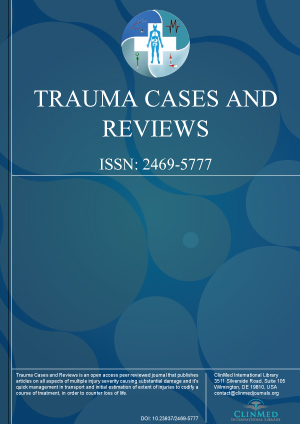Open Access DOI:10.23937/2469-5777/1510079
Complex Thoraco-Abdominal Trauma: Transdiaphragmatic Intercostal Hernia and Rib Fractures
Sally Shepherd, MD, Annelise Cocco, MBBS, FRACS, Phillip Antippa, MBBS, FRACS and Jacob McCormick, MBBS, FRACS
Article Type: Case Report | First Published: October 14, 2019
Injuries to the costal margin which involve herniation of abdominal contents into the chest are rare. Two major mechanisms of transdiaphragmatic intercostal hernia are recognised: post-traumatic and spontaneous. It is hypothesised that disruption of either the diaphragm or intercostal muscles leads to herniation of the abdominal contents, and that negative intra-thoracic pressure then draws the herniated viscera further into the chest. A 66-year-old male was transferred to the emergency departme...
Open Access DOI:10.23937/2469-5777/1510078
Isolated Avulsion Fracture Lesser Tuberosity of the Humerus, a Rare Presentation Post Seizure
Jaya TS, Hadizie D and TMS Muzaffar
Article Type: Case Report | First Published: September 18, 2019
Isolated humeral lesser tuberosity fracture is rare and is usually associated with fractures of the proximal humerus. Trauma precedes most reported cases. We report a isolated fractured lesser tuberosity occurring in a gentleman post seizure. Open reduction and internal fixation was performed. Functional outcome was successful, and the patient regained his normal pain-free shoulder function 3 months surgery. Avulsion Fracture Lesser Tuberosity of The Humerus is a rare injury that usually occurs...
Open Access DOI:10.23937/2469-5777/1510077
Successful Non-Operative Management of Multi-Trauma Patient Suffering from Multiple Intra-Abdominal Injuries - A Case Report
Georgios Theodoros Liagkos, MD, Christos Chouliaras, MD, Aris Papadopoulos, MD and Constantine Vagianos, MD
Article Type: Case Report | First Published: September 14, 2019
Trauma represents the main cause of death among people under the age of 35 worldwide. Until the 90s, the operative management (OM) was the golden standard of treatment for trauma patients with abdominal bleeding. Over the last few decades, though, a shift has been made from operative to non-operative management (NOM) in haemodynamically stable trauma patients with findings of recent intra-abdominal bleeding and no signs of peritonitis. However, NOM may be particularly challenging in patients wit...

